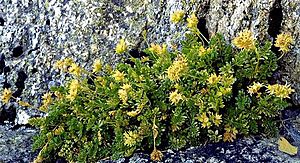Castle Crags ivesia facts for kids
Quick facts for kids Castle Crags ivesia |
|
|---|---|
 |
|
| Scientific classification | |
| Genus: |
Ivesia
|
| Species: |
longibracteata
|
Ivesia longibracteata, also known as Castle Crags ivesia or longbract mousetail, is a very rare flowering plant. It belongs to the rose family, just like the roses you might see in a garden!
This special plant is endemic to Shasta County, California. This means it grows naturally only in this specific area and nowhere else in the world! You can find it in a place called Castle Crags, where it loves to grow in rocky areas made of granite. It thrives in the cool, wet environment of a temperate coniferous forest, which is a type of forest with cone-bearing trees like pines and firs.
What is Castle Crags Ivesia?
The Castle Crags ivesia is a perennial herb. This means it's a plant that lives for more than two years, coming back each growing season. It forms a green, somewhat sticky clump of leaves that grows right out of cracks in granite rocks.
How Does It Look?
The leaves of this plant are quite small, usually about 2 to 4 centimeters long. Imagine a small paperclip; that's roughly how long they are! Each leaf is made up of several pairs of tiny leaflets that have a slightly lobed or bumpy edge.
When it blooms, the plant produces a cluster of several small flowers. This cluster, called an inflorescence, looks like a small head and is about 1 or 2 centimeters wide. Each individual flower is tiny, less than a centimeter long, and has delicate, pale yellow petals.

